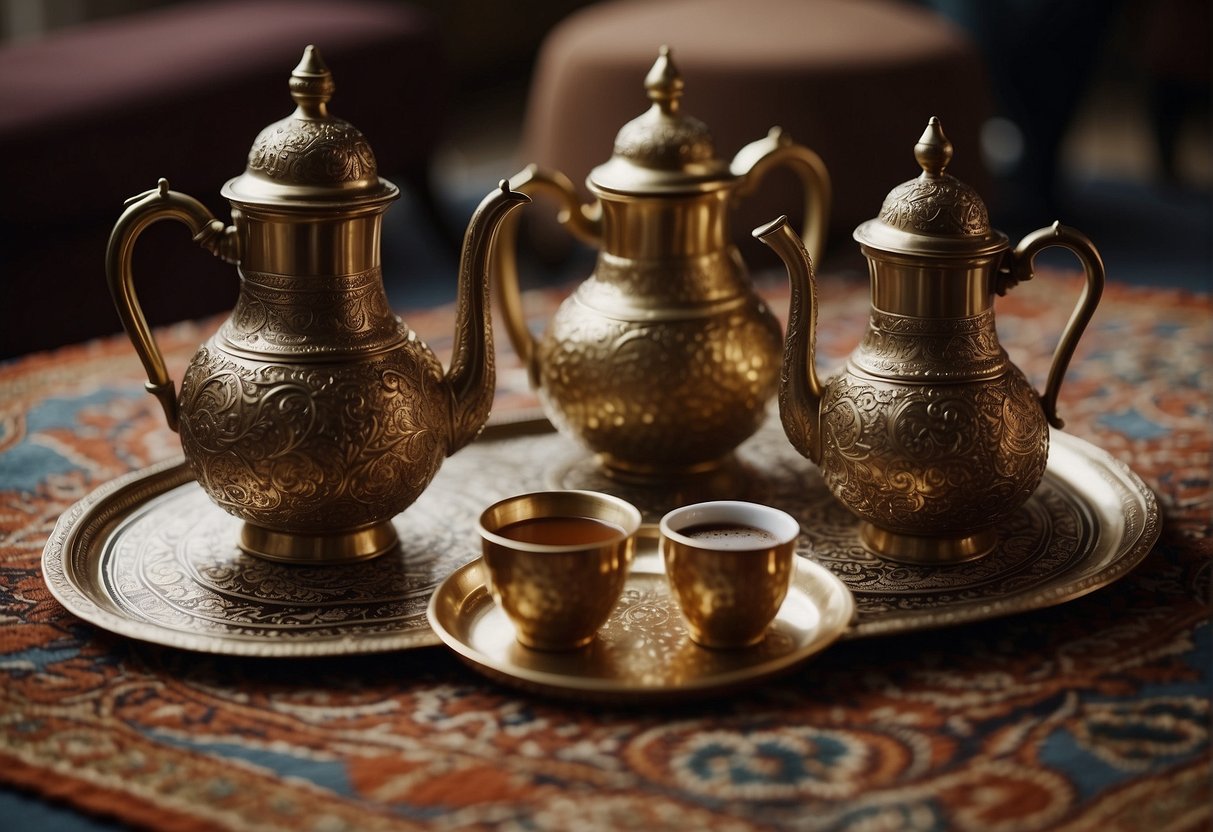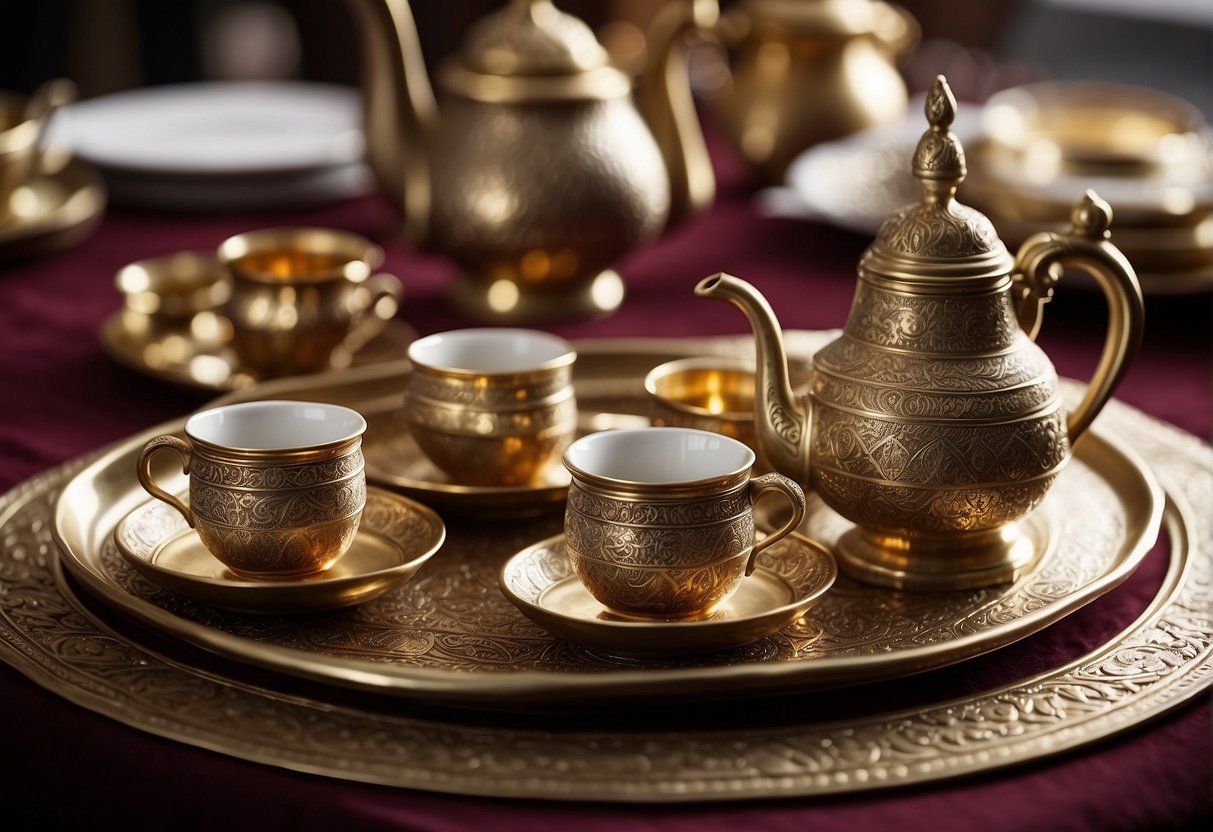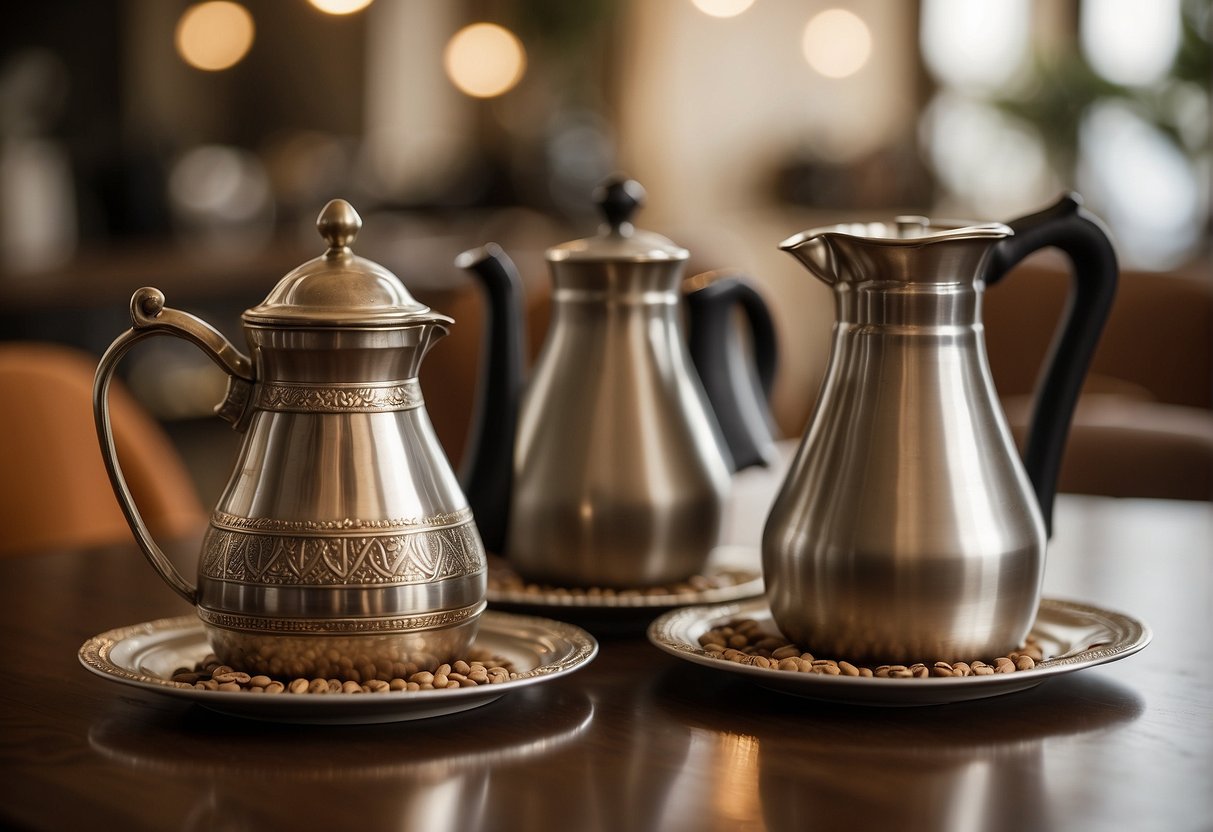Arabic coffee and Turkish coffee hold distinctive places in the rich tapestry of Middle Eastern culture. Your interest in these beverages isn’t just about taste; it’s a step into centuries-old traditions that are steeped in history. Arabic coffee is often associated with hospitality and ceremonial conduct, especially throughout the Arabian Peninsula. A sign of warm welcome, serving Arabic coffee is a ritual, complete with its specific set of customs, such as the delicate pouring from a dallah and the offering of dates to complement the drink’s taste.

When you shift your attention to Turkish coffee, you’re looking at a method that has been preserved since the days of the Ottoman Empire. The preparation is an art form, involving finely ground coffee beans and a unique brewing technique that results in a strong, unfiltered coffee. It’s a cultural phenomenon in Turkey and the surrounding regions, where the coffee’s presence is a staple not just in homes but in the proverbial Turkish coffee houses that became social hubs. Turkish coffee’s influence is so significant that it was inscribed on the Intangible Cultural Heritage List by UNESCO.
While you may find similarities in the integral role both coffees play in their respective cultures, the distinctions in taste, preparation, and presentation speak volumes about the diversity that exists within shared geographical spaces. The respect for tradition in making and serving these coffees continues to shape social interactions and reinforces a sense of identity among communities in the Middle East. Enjoying either Arabic or Turkish coffee isn’t just a casual sip of caffeine; it’s an experience that connects you to a history and a people who cherish their coffee as a symbol of their heritage.
Historical Origins and Cultural Significance
https://www.youtube.com/watch?v=tiu4FgcUY5c&embed=true
When you explore the roots of Arabic and Turkish coffee, you’re delving into centuries-old traditions and the cultural fibers that define hospitality in the Middle East and beyond. Arabic coffee, a symbol of generosity, began in Yemen, while Turkish coffee’s journey started in the Ottoman Empire, evolving into a social pillar in households and coffeehouses across various cultures.
History of Arabic Coffee
Arabic coffee, or ‘qahwa’, has its origins deeply rooted in the history of Yemen, where coffee plants, specifically Arabica beans, were first cultivated. Its discovery often attributes to an Ethiopian shepherd named Kaldi, who noticed his goats becoming energetic after eating certain berries. Monks supposedly made the first coffee from these berries, paving the way for a cherished tradition. By the 15th century, it had become a staple of the Arab world, symbolizing hospitality and tradition, especially when served with dates.
History of Turkish Coffee
The introduction of coffee to Istanbul in the 15th century by the Ottoman Empire marks the beginning of Turkish coffee history. Istanbul’s position as a cultural crossroads led to the spread of coffee throughout Europe, primarily via the Balkans. The method of finely grinding coffee peculiar to Turkish coffee gives it a distinctive taste and texture, appreciated in the cultural practice ever since.
Role in Social and Hospitality Rituals
In both cultures, coffee transcends being a mere beverage—it’s a symbol of hospitality, an essential aspect of social gatherings, and a social ritual in itself. Arabic coffee is often enjoyed in a sociable, yet ceremonial fashion, usually served after meals amidst conversation. Turkish coffee’s significance is such that it’s customarily offered to guests as a gesture of welcome and has played a defining role in social rituals within coffeehouses across Europe since the 17th century. Whether it’s a quiet morning or an animated evening, these coffee traditions remain at the heart of daily life, fostering a sense of community and belonging.
Beans and Roasting Methods
https://www.youtube.com/watch?v=ichM2KPUMak&embed=true
You’ll find that both Arabic and Turkish coffee have unique characteristics when it comes to the beans they use and how they’re roasted. Your appreciation for each brew might deepen as you explore these differences.
Types of Beans Used
Arabic and Turkish coffees prioritize Arabica beans, known for their sweeter, more complex flavor profile and lower caffeine content compared to Robusta beans. Specifically, Arabic coffee often incorporates a higher percentage of Arabica beans, celebrated for their nuanced and varied flavor profiles. These profiles can range from sweet and fruity to silky and spicy, depending on their origin and processing.
Turkish coffee also typically uses Arabica beans, but it’s not unusual to find Robusta or a blend used for a stronger flavor and caffeine kick. The grind for Turkish coffee is distinctive—exceptionally fine, like powdered sugar, which is essential for the signature preparation method.
Roasting Preferences
When it comes to roasting, Arabic coffee typically features beans roasted to a light or medium degree. This level of roasting helps maintain the beans’ original flavor and aroma, lending a lighter, more fruity or floral taste to the coffee. Roasting for Arabic coffee is done with care to bring out these delicate, complex flavors without introducing the bitterness associated with darker roasts.
| Roast Type | Arabic Coffee | Turkish Coffee |
|---|---|---|
| Light Roast | Common | Less common |
| Medium Roast | Preferred | Sometimes used |
| Dark Roast | Less common | Preferred |
Conversely, Turkish coffee often sees beans roasted to a dark roast, giving the coffee a more potent, bolder flavor profile. A dark roast imparts a robust, slightly bitter, and less acidic taste, which is a hallmark of traditional Turkish coffee. This roasting level also produces a pronounced aroma that can be enjoyed before sipping the coffee.
Preparation and Brewing Techniques

Discover how the traditional methods of preparing Arabic and Turkish coffee bring out unique flavors and aromas. Your coffee experience is shaped significantly by these distinct brewing techniques.
Arabic Coffee Preparation
Arabic coffee, or ‘qahwa,’ is traditionally prepared with a light roast and ground to a fine consistency. Water is brought to a boil in a ‘dallah,’ a distinctive tall pot. Once the water is hot, the ground coffee gets added with spices like cardamom and sometimes saffron for that signature flavor. Here’s a step-by-step guide:
- Boil water in the dallah.
- Add finely ground coffee and spices.
- Heat gently until it begins to froth.
- Pour and serve, allowing grounds to settle.
Turkish Coffee Preparation
For Turkish coffee, the preparation takes a slightly different approach. The coffee, extremely finely ground, is combined with water and sugar (if desired) directly in a ‘cezve’ or ‘ibrik,’ a small, long-handled pot. The mixture is then simmered over low heat and frequently includes cardamom. The key steps are:
- Combine water, finely ground coffee, and sugar in the cezve.
- Simmer on low heat, watching for the foam to rise.
- Remove from heat just before boiling and repeat this process to enhance the foam.
- Serve immediately, foam on top.
Serving Style and Accessories

You’ll find that both Arabic and Turkish coffees have unique and rich traditions when it comes to serving styles and accessories that enhance the overall coffee experience.
Traditional Serving Vessels
Arabic Coffee: Traditionally, Arabic coffee is served from a dallah, a distinctive coffee pot often made of brass or stainless steel, which may have intricate designs. The pot has a long spout, which makes pouring into small cups without handles (commonly known as finjan) an elegant art.
Turkish Coffee: The Turkish coffee is famously prepared and served in a cezve, a small long-handled pot typically made of copper or brass. Your coffee will likely be poured into small, ornate cups aptly called fincans. These cups also lack handles and are known for their intricate designs.
Accompaniments and Presentation
When you’re handed a cup of Arabic or Turkish coffee, it’s often accompanied by an offering of sweet treats that complement the strong flavors.
- Arabic Coffee: Expect to enjoy your coffee with dates or sometimes even with other regional sweets that may vary depending on the locality.
- Turkish Coffee: It’s common to receive your coffee alongside Turkish delight or baklava, each offering a sweet counterbalance to the robust, often bitter coffee.
The presentation of both coffee types is steeped in tradition and is an integral part of the hospitality customs of their respective cultures, often signifying warmth and friendship.
Taste, Flavor, and Sensory Experience

Arabic and Turkish coffees offer distinct taste profiles and sensory experiences that are influenced by their unique preparation methods and cultural significance. You’ll find different textures, appearances, and flavor nuances in each cup.
Comparing Taste Profiles
Arabic Coffee:
- Flavors: Generally, you’ll taste a lightly spiced, often slightly floral and cardamom-infused brew. It’s less about the bitterness and more about the delicate aromas.
- Aroma: Arabic coffee provides a full-bodied scent, usually enhanced with ingredients like saffron.
Turkish Coffee:
- Flavors: Expect a more prominent bitterness, complemented by the rich, earthy notes typically associated with dark, black coffee.
- Aroma: The aroma of Turkish coffee is potent, often with a roasted, sometimes smoky character.
Texture and Appearance
Arabic Coffee:
- Texture: Tends to be lighter, with less foam on top.
- Appearance: It is usually a paler color compared to Turkish coffee, sometimes with visible spices.
Turkish Coffee:
- Texture: Notable for its thick, velvety texture with a dense foam – known as ‘crema’ – on top.
- Appearance: Darker in color, often opaque, indicating its unfiltered nature.
Frequently Asked Questions

In this section, you’ll find answers to some common queries about the distinctive brewing methods, flavor profiles, serving traditions, caffeine content, bean varieties, and potential health benefits of Arabic and Turkish coffee.
What are the main differences between Arabic and Turkish coffee brewing methods?
Arabic coffee is often brewed using a method called ‘dallah’ where the coffee grounds, water, and cardamom are brought to a boil together. In contrast, Turkish coffee involves simmering the finely ground coffee directly in a special pot known as a ‘cezve’ or ‘ibrik.
What distinguishes the flavor profiles of Arabic and Turkish coffee?
The flavor of Arabic coffee is typically milder and has a hint of spices like cardamom, whereas Turkish coffee is generally stronger, slightly bitter, and may include sugar during the brewing process for sweetness.
Can you explain the serving traditions for Arabic and Turkish coffee?
Arabic coffee is served in small cups without handles, called ‘finjan,’ and is often accompanied by dates or sweets. Turkish coffee is poured into similar small cups and is known for the thick, pudding-like foam on top that is considered a sign of good preparation.
How do the caffeine contents compare in Arabic and Turkish coffee?
Despite their strong flavors, both Arabic and Turkish coffee have caffeine contents comparable to or slightly higher than regular brewed coffee, depending on the grind, the amount of coffee used, and the brew time.
What types of beans are typically used for making Arabic and Turkish coffee?
Arabica beans are commonly used for both Arabic and Turkish coffee due to their superior flavor profiles. The beans for Turkish coffee are ground to a fine powder, finer than for any other preparation method.
Are there any health benefits associated with drinking Arabic or Turkish coffee?
Both Arabic and Turkish coffee may offer health benefits due to the presence of antioxidants and beneficial compounds in coffee. However, these should be consumed in moderation as part of a balanced diet.
